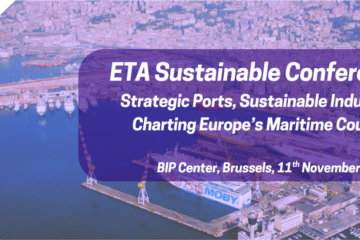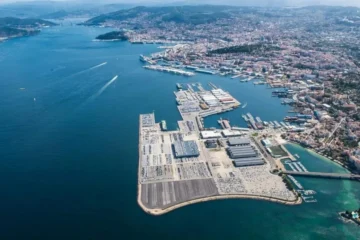ETA held its Sustainable Conference in Brussels, on the 11th of November. The event had as theme “Strategic ports, sustainable industry: Charting Europe´s maritime course” and explored the future role of Europe’s ports and port services in the context of the upcoming European Maritime Industrial Strategy and European Port Strategy, which will set the course for the EU’s maritime policy in the years ahead. The event brought together European Commission officials and representatives of diferent sectors of the maritime industry.
40 delegates attended the conference which took place at the BiP center, in the heart of the Belgian capital. ETA Vice Chairman Holger Schwesig opened the session by underlining the importance of towage, which he described as the “hidden engine” of port operations and a strategic partner in achieving the goals of the European Maritime Industrial Strategy and the European Port Strategy.
Torsten Klimke, Head of Unit for Ports and Inland Navigation at DG MOVE, briefed the attendees on the the upcoming European Ports Strategy. He described it as a comprehensive document designed to support the long-term competitiveness of European terminals, with a special focus on security and military mobility, energy transition, including helping terminals become energy hubs and digitalisation. The new strategy, that will be published in the first trimester of 2026 will contain a number of actions that addressing the aforementioned areas, but no new legislation is expected.
Dario Bazargan, Policy Officer, DG GROW focused on the Europe’s Maritime Industrial Strategy, which is also expected to be presented in the beginning of 2026. In his presentation Mr Bazargan provided an overview of the current situation of the European maritime manufacturing industry, and the challenges it is currently facing as unfair competition and tensions in the raw materials supply chains. Thus, Mr Bazargan emphasized that the upcoming strategy will address the maritime manufacturing sector in a broad sense, covering strategic sectors as retrofitting, repairing, designing and components building, while strengthening the entire manufacturing cluster, an essential pillar for the safety and security of the continent.
Christophe Tytgat, Secretary General of SeaEurope delivered a compelling presentation on the maritime manufacturing industry´s expectations regarding the upcoming Maritime Industrial Strategy, that he summarised in three main goals: reinforcing Europe’s global leadership in some specific sectors, regaining strategic ship types and fully reaping the benefits of the Blue Economy. In particular Mr Tytgat called for special support in 5 key markets:
1. Strategic autonomy assets like naval ships, underwater assets, and patrol vessels.
2. Complex specialized vessels (e.g., offshore supply vessels, cable layers, dredgers, fishing and research vessels, workboats, and icebreakers).
3. Highly complex ships driving technology advancement (e.g., cruise ships).
4. Shortsea and inland navigation, transport of raw materials and energy.
5. Sustainable retrofit and conversion.
Lamia Kerdjoudj, Secretary General of FEPORT addressed the need for a coherent and comprehensive European maritime policy that supports the competitiveness and resilience of EU ports. She emphasized the importance of establishing a State Aid Framework to strengthen enhance the competitiveness of European terminals, enhancing both physical and cyber security in ports, positioning terminals as key enablers of military mobility, and supporting the green transition of the maritime industry as a whole.
Aileen Van Raemdonck Secretary General at EMPA addressed the matter of workforce and skills, as having a well trained labour, with the up to date green and digital skills is an strategic asset in the port services sector, and thus, a key factor in the competitiviness, safety and security of the European maritime ecosystem.
You can find all the presentations by clicking on the speakers’ names. Check the pictures of the event here.


